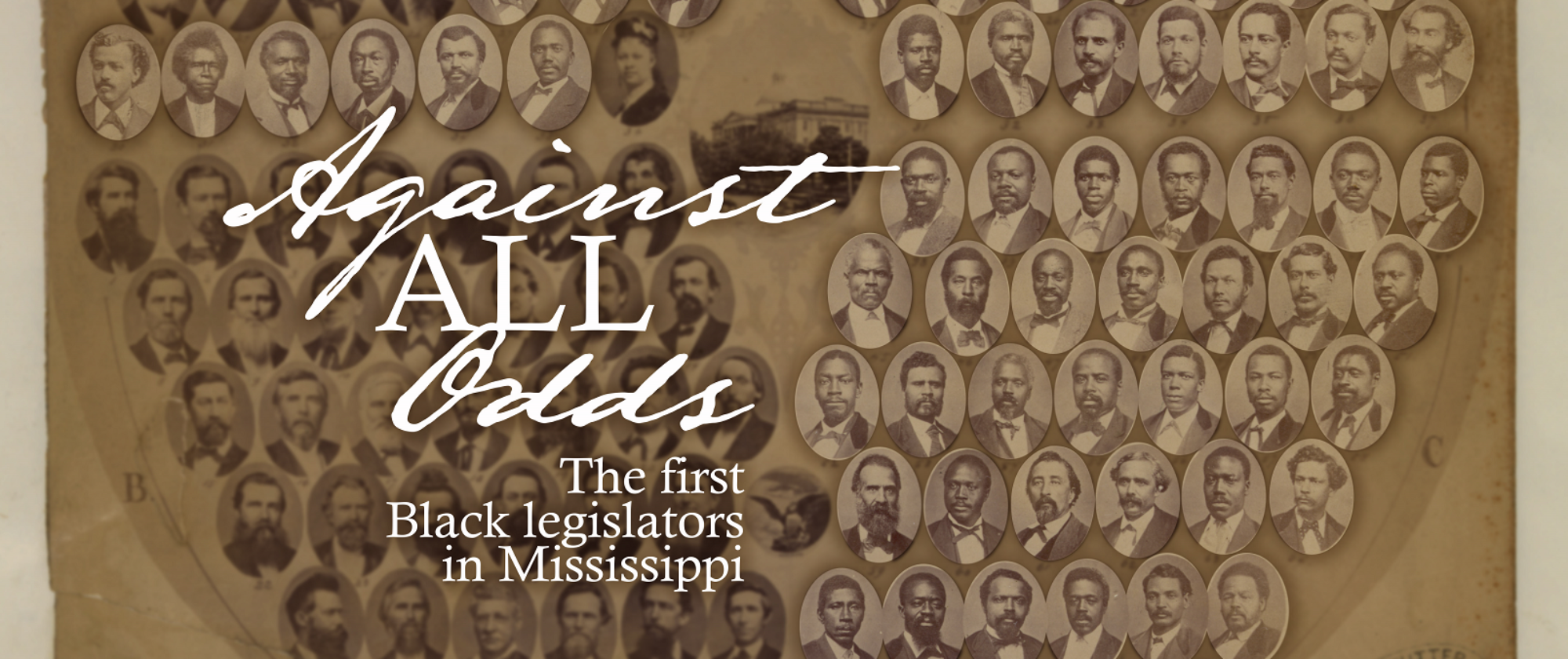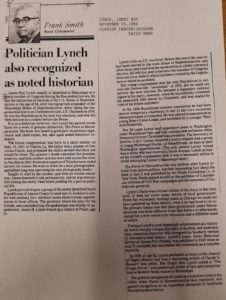[This article mistakenly calls John Roy Lynch “James” throughout. For clarity, I have corrected it to John in my transcript.]
Politician Lynch also recognized as noted historian
John Roy Lynch usually is identified in Mississippi as a black member of Congress during the Reconstruction era. He had the distinction of election to the U.S. House of Representatives at the age of 26, after having served as speaker of the Mississippi House of Representatives. After losing his congressional seat to ex-Confederate Gen. J. R. Chalmers in 1876, he was the Republican in the next two elections, and won the 1880 election in a contest before the House.
It is as a historian, however, that Lynch has gained recent fame for a work of genuine distinction, The Facts of Reconstruction. The book was based in good part on personal experience and observation, but also upon sound historical research.
The future congressman was born to a slave mother on Sept. 10, 1847, at Vidalia, La. His father was a planter of Concordia Parish, and promised the child’s mother that their son would be freed. The planter’s death cancelled the promise, however, and both mother and son were sold across the river to Natchez in 1863. Federal occupation of Natchez soon ended slavery for John. He went to work for a local photographer, and before long was operating his own photography studio.
Taught to read by his mother, and with no formal education, John learned to talk persuasively, and he was soon active among the newly freed black pushing for a part in political life.
Lynch prevailed upon a group of the newly identified black Republicans of Adams County to send him to Jackson to confer with military Gov. Adelbert Ames about various appointments to local offices. The governor heard his plea for his friends, and concluded that the spokesman was worthy of appointment. John R. Lynch wound up a Justice of Peace, age 21.
Lynch’s role as J.P. was brief. Before the end of the year he had been elected to the state House of Representatives, and after three years had won the speakership in a hotly contested election. He left that post to become the member of Congress from the river district which had been created by the Legislature in which he presided.
The young congressman was the only Republican to survive the Democratic “revolution” of 1875, but he could not survive the next election. He became a legendary national figure in his party, however, when he successfully contested his presumed 1880 defeat by Chalmers, and was seated by vote of his fellow members.
At the 1880 Republican national convention he had been chosen temporary chairman in one of the rare occasions when such a post is contested. He was placed in nomination by young Henry Cabot Lodge, and seconded by a younger Theodore Roosevelt.
For 20 years Lynch held appointive posts in Washington under Republican rule, and had considerable influence while Democrat Grover Cleveland was president. The Secretary of Interior, L. Q. C. Lamar, honored Lynch’s request that a group of young Mississippi blacks, all Republicans, be kept in their Washington appointments. (The only person Lamar vetoed was a white who had married a black woman. Lynch accepted his friend’s explanation that it was a necessary action to avoid destroying Lamar’s Mississippi base.)
The Facts of Reconstruction was written after Lynch retired from active politics. Another interesting fact about the book is that it was published by the Neale Publishing Co. of New York. Neale gained wealth as the publisher of Confederate versions of Civil War campaigns and the memoirs of Confederate generals.
Lynch’s Facts was a broad outline of the story at the state level. It does not cover many details of local government. From his retirement vantage point in Chicago he could not have gathered up these details, even if he had tried to do so. His primary theme was that state government under Reconstruction was little different from that before or afterwards, except for a new concern for education and a different mass of voters.
Perhaps Lynch’s most important achievement as a historian was to sharply critique the work of the first, and most eminent, American historian who accepted the Southern version of Reconstruction history. Lynch’s paper, Some Historical Errors of James Fort Rhodes, was published in 1922 when he was 75 years old, but establishes his credentials as a valuable historian.
In 1929, at age 82, Lynch published an essay in the Journal of Negro History that was a shattering review of Claude G. Bowers’ best seller, The Tragic Era. Lynch called it “The Tragic Error,” and pointed out errors of fact and interpretation as Bowers’ book related to Mississippi.
The general recognition of Lynch as a historian came in the 1960s, when Facts of Reconstruction was reprinted, and gained recognition as an important document of American Reconstruction history.

